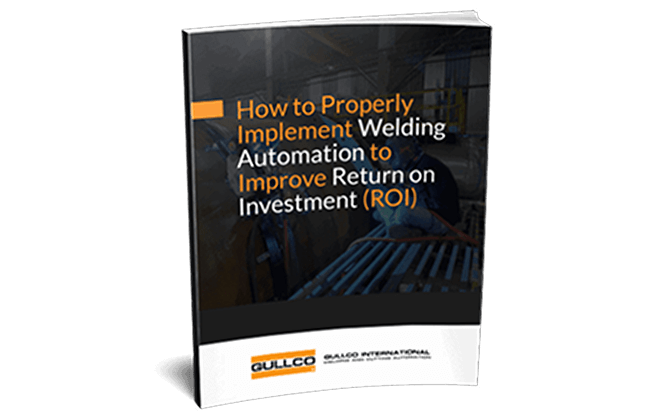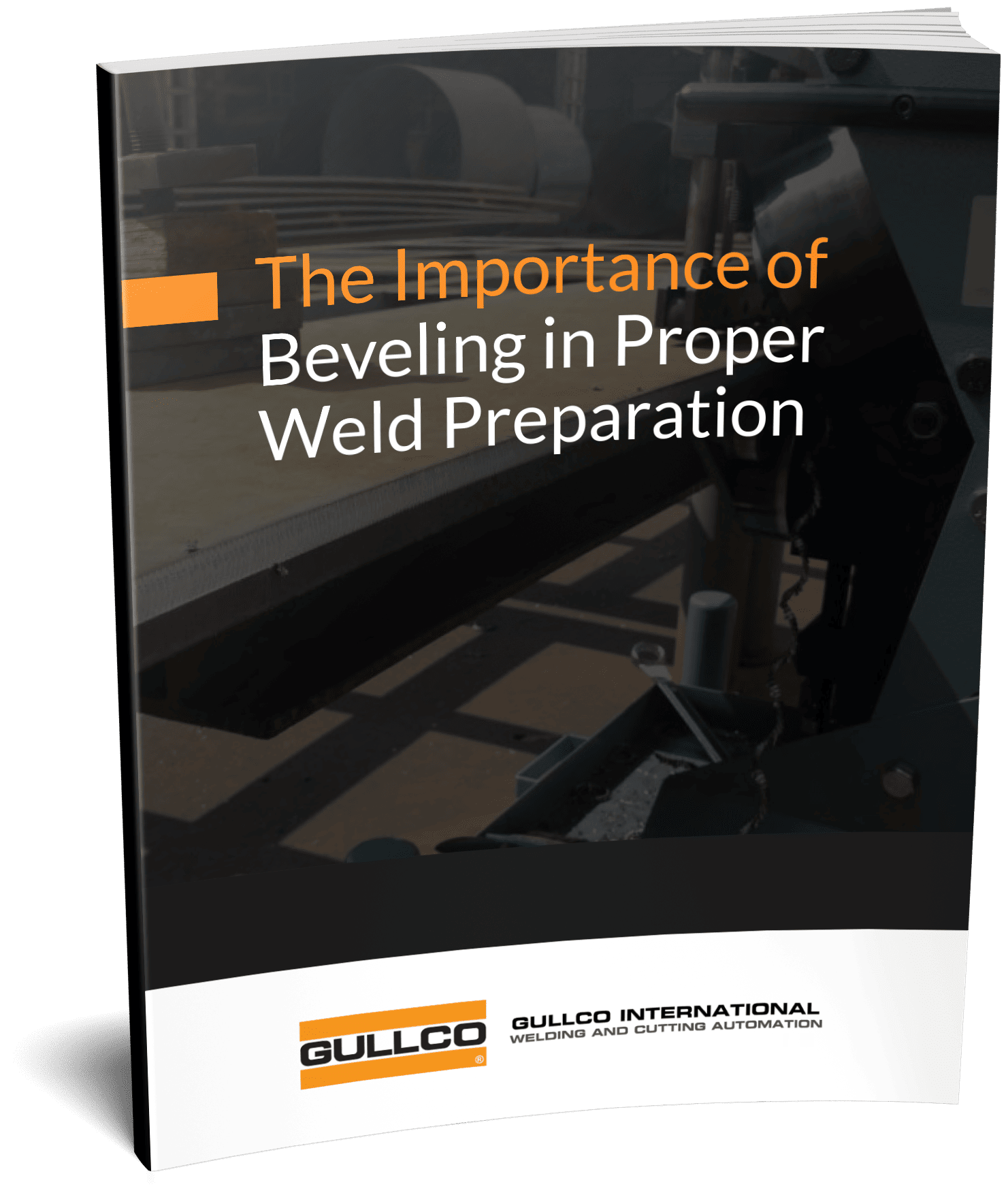Contents
Quick Summary: Precision beveling is key to achieving high-quality welds, whether in shipbuilding, heavy manufacturing, or structural steel fabrication. Learn how beveling enhances surface area, eliminates weak points, and ensures a flawless weld shape. With over 65 years of expertise, Gullco provides durable, portable beveling machines that integrate seamlessly into your production line. Find out how our automated solutions can enhance welding efficiency and improve the longevity of your metal joints.
Welding processes create a solid, reliable joint to connect two previously disconnected metal pieces or components. High-quality welding joints can be achieved through a wide variety of different tools, techniques, and heated substrates. The processes can be manual or fully automated. However, each welding technique comes with different advantages and constraints that can make one option a better fit than another for a specific project. For example, most welding machines have a maximum weld thickness they can provide and would have to commit to multiple-pass welds to create a proper weld for joining very thick pieces. As material thickness increases, beveling is a vital part of joining the materials and involves key preparation parameters such as bevel angle, face and land.
In this guide, we walk through what beveling is, its core functions and advantages, some of the most important things you need to know about beveling, and how Gullco can help provide consistently excellent beveling automation equipment for your production and fabrication needs.
What is Beveling?
Beveling is a pre-welding process that manufacturers and finishing service providers use to prepare parts for welding. Manufacturers cut or shere the joining edge of metal pieces at a diagonal angle against the thickness of the metal piece. This process creates a precise, angled slope with a greater surface area for the weld. It also reduces the thickness of the butting endings of two joining metal pieces, helping to improve weld fusion and improve the overall strength of the weld. During welding, the filler metal will be applied here to penetrate and fill the gap.
This style of preparation allows welders to create strong joints to join the two butting pieces. Not only is the weld joint itself stronger, but there’s a reduced risk of centerline cracking over time. Welders can further modify the beveling process by creating a “double bevel” that they can then weld with no risk of leaving any space at the crux of the V-shaped gap.
In the case of welding, beveling and chamfering are often interchangeable as many weld prep bevels have an angled cut that only goes a portion of the way down the edge of the plate, leaving a portion of the original material at the bottom. This is known as the “land” of the bevel.
Why is Beveling Important
Beveling provides several crucial advantages when it comes to creating high-quality, fail-proof welds. Some of the core benefits of taking the time to introduce a beveling step to your production process include:
- Increased Surface Area Creates a Stronger Bond: When a weld joint is holding onto metal pieces only by a thin metal edge, it puts excess pressure on the weld site. Even the best welding compounds and processes rely on having a suitable surface area for the weld to adhere to. Beveling the surface provides the extra surface area the weld needs, and a diagonal cut across metals of any thickness will always provide more surface area than a straight, square cut. This minimizes the risk of centerline cracking and a weld joint that weakens over time.
- Heavy-Duty Applications: In many standard consumer and commercial applications, a beveling step is not necessary for creating a strong weld that complies with industry regulations and specifications. However, beveling and welding do give components more resistance to damage, making them more fit for heavy-duty applications that undergo regular applications of stress throughout their operational lifespan.
- Simplicity: Whether your manufacturing processes use manual or automated welding techniques, easy access to the weld is crucial. Automated machinery needs to be able to efficiently access the joint, potentially without having the full dexterity of human technicians. Human welders need to have complete visibility to the site so they can apply a strong, consistent weld.
- Aesthetic Production: Through beveling, welders can more easily create straight, uniform welds that give the finished product a more reliable and aesthetically pleasing look. This can be crucial for making sales in both B2C and B2B markets.
Must-Knows About Weld Preparation
Just like there are multiple different types of welding styles and techniques, there are multiple different beveling styles that manufacturers can perform based on a product’s specifications. Some of the different factors that can be controlled during beveling and before welding takes place are:
- The Degree of the Angle: The angle of the bevel changes depending on the application. Pipe welding bevels typically require a 37.5-degree angle, but other metal applications require different angles.
- The Length of the Bevel: This factor needs to be accurately cut and measured to ensure the welding is done with an appropriate amount of welding material and is always consistently applied.
- Speed: Manufacturers need to provide quick beveling, especially if it’s a new step added to a bulky production process. However, moving too quickly can negatively affect the quality of the cut and lead to inaccurate fit-up of the materials and a weaker weld.
- Do Not Heat the Metal to Be Welded: Welding is a precision operation, and the amount of chromium, magnesium, and iron in the metal all impact how the welding will be completed. Preheating metal can change the internal characteristics and even the composition of the metal, producing inconsistent results. Some beveling machines, such as the KBM-18, use a shearing process that does not leave a heat affected zone.
- Beveling Fumes: Both welding and beveling processes produce potentially hazardous fumes. Any workers in the area need to have the appropriate safety gear so the vapors don’t put them at risk. The KBM® shearing method strips the material from the weldment without any noise or vapor.
What to Consider When Beveling
Consider these factors when conducting your beveling processes or working with a third-party service provider:
- Emissions: If the beveler generates emissions, then workers either need to be far away from the processing equipment or have all appropriate ventilation and safety gear.
- Oxide-Free Cutting Edges: Oxide-free edges typically require a rotating cutter head that provides a burr-free edge.
- Machine Speed: Since speed can impact cut quality, strike the right balance between quality and efficiency.
- Weld Shape: Both automated machinery and manual welders need to know the exact shape of the weld and any other requirements before the project begins.
- Adjustments: If you’re newly incorporating beveling into the production process, create a prototype so your team can adjust the bevel angle as needed.
Partner with Gullco for your Automated Beveling Needs
Gullco is a leading provider of portable plate beveling machines for industrial production and welding applications. If your metal fabrication facility doesn’t have an in-house machine, Gullco is here to help you find the right machine for your needs. Our available models include:
- KBM-18 Portable Plate Beveler
- KBM-28 Heavy Duty Portable Plate Beveling Machine
- KBM-18U Underside Plate Beveler
- KBM-28U Heavy Duty Underside Plate Beveler
Key benefits of working with Gullco for automated beveling services include:
- Superior customer service
- On-site training
- Product durability
- Complex problem-solving capabilities
For over 65 years, Gullco International has specialized in providing welding solutions that fit the unique needs of manufacturers across different industries and markets. We offer complete customer service to ensure that we match you with the right portable beveling machine for your organization’s current and future needs so equipment never holds back your growth and ability to scale fabrication. Our customizable automation solutions include options for welding, cutting, beveling, and other task automation. Contact us today to learn more about our beveling machines and how our machines can fit into your fabrication shop’s existing processes. Request a quote for pricing details or to start your order.
Relevant Resources


Frequently asked questions
Find quick answers to your questions here, ask our AI assistant, or contact us for any additional inquiries.
Gullco’s automation solutions can be tailored to fit most applications. Our products are designed for flexibility and customization. To determine the best approach for your needs, please provide some details about your project. We’re happy to discuss how we can help you achieve optimal results.
Thanks for your interest in Gullco products! For accurate pricing and to discuss your specific needs, we recommend you Request a Quote and your local distributor will promptly respond.
Gullco International has presence worldwide. To locate the distributor in your area, visit our distributor locator and choose your region and location.
Absolutely! We’d be happy to schedule a product demonstration for you. Please let us know which product(s) you’re interested in and your preferred date and time, and we’ll get that arranged. We look forward to showing you how Gullco can improve your operations.
You can locate your product manual in our Resource library.
That’s a great question! We’re really proud of the ruggedness of our Gullco products. A big part of it comes from our commitment to North American manufacturing. We’ve invested over $12 million in state-of-the-art CNC equipment to ensure precision and durability. Plus, we do most of the manufacturing in-house, which gives us tight control over quality.
Ready to get started?
With over seven decades of experience and a worldwide reach, we synthesize the skills, knowledge, and experience to offer reliable, innovative solutions to automate welding and associated processes. We are committed to continual improvement, developing new welding automation systems and equipment to address the ever-changing needs of the industry.











